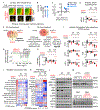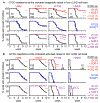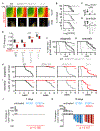SOS1 Inhibition Enhances the Efficacy of KRASG12C Inhibitors and Delays Resistance in Lung Adenocarcinoma
- PMID: 39437166
- PMCID: PMC11695159
- DOI: 10.1158/0008-5472.CAN-23-3256
SOS1 Inhibition Enhances the Efficacy of KRASG12C Inhibitors and Delays Resistance in Lung Adenocarcinoma
Abstract
The clinical effectiveness of KRASG12C inhibitors (G12Ci) is limited both by intrinsic and acquired resistance, necessitating the development of combination approaches. Here, we identified targeting proximal receptor tyrosine kinase signaling using the SOS1 inhibitor (SOS1i) BI-3406 as a strategy to improve responses to G12Ci treatment. SOS1i enhanced the efficacy of G12Ci and limited rebound receptor tyrosine kinase/ERK signaling to overcome intrinsic/adaptive resistance, but this effect was modulated by SOS2 protein levels. G12Ci drug-tolerant persister (DTP) cells showed up to a 3-fold enrichment of tumor-initiating cells (TIC), suggestive of a sanctuary population of G12Ci-resistant cells. SOS1i resensitized DTPs to G12Ci and inhibited G12C-induced TIC enrichment. Co-mutation of the tumor suppressor KEAP1 limited the clinical effectiveness of G12Ci, and KEAP1 and STK11 deletion increased TIC frequency and accelerated the development of acquired resistance to G12Ci, consistent with clinical G12Ci resistance seen with these co-mutations. Treatment with SOS1i both delayed acquired G12Ci resistance and limited the total number of resistant colonies regardless of KEAP1 and STK11 mutational status. Together, these data suggest that targeting SOS1 could be an effective strategy to both enhance G12Ci efficacy and prevent G12Ci resistance regardless of co-mutations. Significance: The SOS1 inhibitor BI-3406 both inhibits intrinsic/adaptive resistance and targets drug tolerant persister cells to limit the development of acquired resistance to clinical KRASG12C inhibitors in lung adenocarcinoma cells.
©2024 American Association for Cancer Research.
Conflict of interest statement
The Kortum laboratory receives funding from Boehringer Ingelheim to study SOS1 as a therapeutic target in
Figures







Update of
-
SOS1 inhibition enhances the efficacy of and delays resistance to G12C inhibitors in lung adenocarcinoma.bioRxiv [Preprint]. 2023 Dec 15:2023.12.07.570642. doi: 10.1101/2023.12.07.570642. bioRxiv. 2023. Update in: Cancer Res. 2025 Jan 2;85(1):118-133. doi: 10.1158/0008-5472.CAN-23-3256. PMID: 38106234 Free PMC article. Updated. Preprint.
References
-
- Gridelli C, Rossi A, Carbone DP, Guarize J, Karachaliou N, Mok T, et al. Non-small-cell lung cancer. Nat Rev Dis Primers 2015;1:15009. - PubMed
-
- Janes MR, Zhang J, Li LS, Hansen R, Peters U, Guo X, et al. Targeting KRAS Mutant Cancers with a Covalent G12 C-Specific Inhibitor. Cell 2018;172:578–89 e17 - PubMed
MeSH terms
Substances
Grants and funding
LinkOut - more resources
Full Text Sources
Medical
Molecular Biology Databases
Miscellaneous

